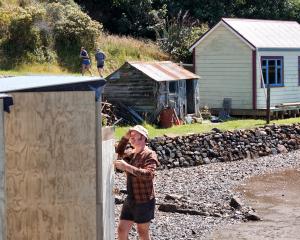Charmian Smith talks to Michael Findlay about some of Dunedin's early Modernist buildings.
New Zealand might be far away from the hotbeds of Modernism in Europe and the US, but we were not necessarily behind the time, says Michael Findlay, professional practice fellow in design studies at the University of Otago.
Striking Modernist buildings were going up in Dunedin at the same time as many in Europe and the US, said Mr Findlay, who has contributed several articles on Dunedin buildings to the recently published Long Live the Modern: New Zealand's new architecture 1904-1985.
The Modernist movement started in the early 1920s as part of the revulsion to the state of society that had led to World War 1 (1914-1918), and it spread through all art forms.
Architects wanted to produce buildings that were new and different from what had gone before and to improve living conditions.
They were concerned with health, open air, exercise and a vigorous body, and this was expressed architecturally as clean, white, almost mechanical buildings that were designed to suit their function rather than an aesthetic idea.
French architect Le Corbusier defined a house as "a machine for living in".
People were shocked and fascinated by the new style, a bit like the more recent reaction to Frank Gehry's Guggenheim museum in Bilbao, Mr Findlay said.
However, in the late 1920s and '30s, several styles developed: The international, ultra-modern, such as Le Corbusier's Villa Savoye set in a grass field in France, a spare white box on poles with roof terraces, ramps and long, metal-framed, horizontal windows; American streamlining with curved walls and windows and tubular railings suggestive of great ocean liners, locomotives and aeroplanes; decorative art deco buildings such as the Chrysler Building in New York; and Spanish mission and romantic Hollywood styles from California.
New Zealand architects kept up with the latest trends, receiving international architectural magazines only weeks after publication.
Whether they were trained here or in Britain, many travelled widely and often worked in Britain and were part of the Modernist movement there too, Mr Findlay said.
One of the significant Modernist houses in Dunedin was built for Arthur Hudson and his family in 1938.
According to his family, who still live in the house, they did not want gables and steep roofs and Mrs Hudson asked for lots of light and windows.
Eventually, the architect said "Mrs Hudson, if you want more windows, I won't be able to hold the roof up!"Designed by Dunedin architects Mandeno and Fraser, who also designed the Dunedin Town Hall, the Hudson house is Spanish mission style, with a rough white plaster exterior,
pillars on the entrance veranda, exposed beams, and tiled interior windowsills.
It also has curved bays with steel-framed windows, and a central hall with unadorned paneling curving around the stairs, lit by a large, first-floor window with stained-glass panes depicting the owners' hobbies: fishing, horses and gardening.
Inside, the rooms are generous, with the drawing room and dining room opening out into the large hall.
Plaster ceilings with geometric decorations, some still with the original Art Deco light fittings, contrast with a dark panelling in the dining room and decorative mullions on the entrance hall doors and internal windows.
Dunedin architects did not adopt all facets of international Modernism but picked out the elements that were going to be appropriate to their clients' needs, Mr Findlay said.
"That has often been interpreted in architectural history as failure or compromise, but I look at it a bit more as an effort to get to grips with new design ideas and manage them in a way that makes them fit the context."
In Dunedin, some architectural firms, such as Miller and White, became known for their Modernist buildings, but others, such as Basil Hooper, wouldn't touch the style.
Many, such as Mandeno and Fraser, could do a variety of styles according to their clients' requirements.
Then, in 1939, with the start of World War 2, it was as if a handbrake had gone on - people were concerned about other things, he said.
After the war, flat-roofed, curvy or geometric suburban houses, familiar in many parts of New Zealand, were being built, often for returned servicemen and people who felt such homes were a modern symbol of progressive design.
By then, Modernism had moved on to a new style, and the cutting-edge architects were designing weatherboard houses with a single-pitched roof with an overhang at the front and floor-to-ceiling windows.
The Modernist buildings
•Some significant Modernist buildings in Dunedin that can be viewed from the street: Former NZR Road Services building, designed by Miller and White, 1939, now part of the Otago Settlers Museum.
•Law Courts Hotel, designed by McDowell Smith in the late 1930s, Lower Stuart St.
•Fletcher Offices, designed by H McDowell Smith c1950, Parry St.
•Lawson and Lousley houses designed by Miller and White (1936-7) on the corner of Pitt St and Heriot Row (see photographs above).
•St John's building, in York Pl, also by Miller and White 1938.
•Unipol Gym (originally Williamson and Jeffreys building), designed by H McDowell Smith c1950, in Anzac Ave.
•House, corner of Smith St and York Pl, designed by Frank Sturmer, of Sturmer and Stone, 1936.
•Speight's Brewery, which Mr Findlay describes as "one of the finest urban industrial buildings in the country", in Rattray St, designed by Mandeno and Fraser, 1938
•NMA Woolstore (now Spotlight) on the corner of Vogel and Crawford Sts - an early piece of modernist industrial architecture also designed in 1928 by Mandeno and Fraser.












